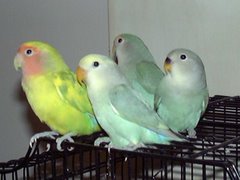Lovebird illness: Learn the Symptom of Lovebird Illness
Lovebirds are really skilled in hiding the symptoms of disease/illness because showing their illness in nature will help the predators to attack them. In order to have the best chance of saving the life of lovebirds, you should lookout for telltale symptoms of sick lovebird.
Early signs of lovebird illness include change in feeding habit, overly quiet, and fluffed feathers. Once your bird shows any of these symptoms, you should approach an avian vet as early as possible to avoid any untoward incident.
The symptoms of lovebird's illnesses are the sequel of some of the lovebird's diseases. Some of the common diseases/ conditions that pave way for sickness are enteritis, respiratory disorders, coccidiosis, intestinal influenza, egg drop syndrome, ticks, mites, internal parasites, bacterial and viral infection (avian pox, polyoma viral, etc), yeast infections (candidiasis) and infighting.
Once your lovebird have shown symptoms of running nose, reduced appetite, dull or watery eyes, sleeping in their enclosure with eyes closed, dull plumage, ruffled feathers cloudy eyes, and soiled vent, you may come to conclusion that your lovebird is going towards the sickness.
Some of the sick lovebirds love to stay near the feeding cup. Even falling from the perch, excessive scratching, sneezing, labored breathing, and tail bobbing are the final symptoms of lovebird illness.
As a responsible lovebird owner, once you found illness in your lovebird, an avian vet check should be the FIRST thing you do! It is always advisable to catch sicknesses first, to be safe than sorry, rather than realize it once it is beyond the reach of the vet.
Early signs of lovebird illness include change in feeding habit, overly quiet, and fluffed feathers. Once your bird shows any of these symptoms, you should approach an avian vet as early as possible to avoid any untoward incident.
The symptoms of lovebird's illnesses are the sequel of some of the lovebird's diseases. Some of the common diseases/ conditions that pave way for sickness are enteritis, respiratory disorders, coccidiosis, intestinal influenza, egg drop syndrome, ticks, mites, internal parasites, bacterial and viral infection (avian pox, polyoma viral, etc), yeast infections (candidiasis) and infighting.
Once your lovebird have shown symptoms of running nose, reduced appetite, dull or watery eyes, sleeping in their enclosure with eyes closed, dull plumage, ruffled feathers cloudy eyes, and soiled vent, you may come to conclusion that your lovebird is going towards the sickness.
Some of the sick lovebirds love to stay near the feeding cup. Even falling from the perch, excessive scratching, sneezing, labored breathing, and tail bobbing are the final symptoms of lovebird illness.
As a responsible lovebird owner, once you found illness in your lovebird, an avian vet check should be the FIRST thing you do! It is always advisable to catch sicknesses first, to be safe than sorry, rather than realize it once it is beyond the reach of the vet.







 Free Ads For Bloggers
Free Ads For Bloggers


1 comment:
Wow. Now i know what to do.
But then again...She died already.
Post a Comment